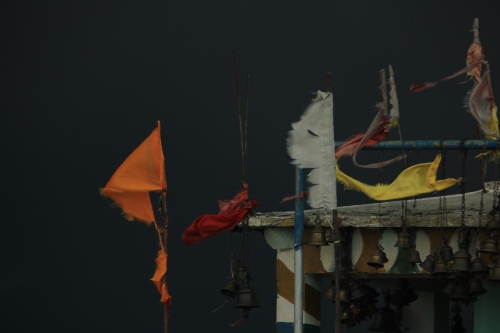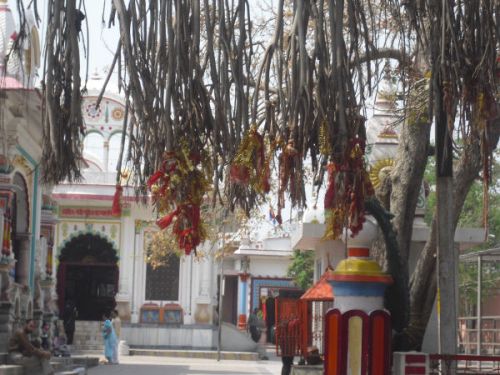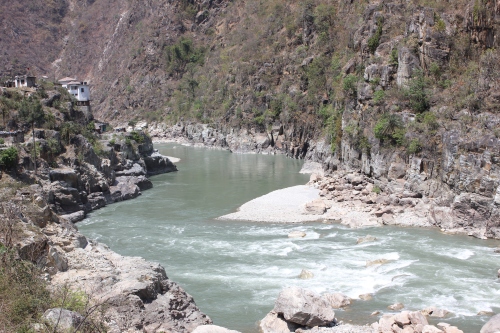(For the sharper eyed readers who are wondering where Part One is, I am still waiting for a chance to cover the first half of the cloud’s route. This post covers its journey into the Himalayas and beyond.)
Kālidāsa’s Megha Dūta needs little introduction. The most famous, and the original, of the sandeśa kāvyas by Sanskrit’s most famous, and almost certainly best, poet has always been one of India’s favourite poems. A yakṣa, cursed to spend a year apart from his wife, is overwhelmed by love sickness at the beginning of the monsoon and sends a cloud to their home in Alakā. The cloud’s route, from Madhya Pradesh up in to the mountains, has been the subject of much discussion. As ever, it is not easy to match the mixture of real and fabled places with modern equivalents – and more so once the cloud enters the Himalayas, the abode of snow, gods and fable.
Here, among the spectacularly large mountains of Uttarakhand, the cloud’s journey towards Mount Kailāsa is painted in the luminous colours of myth, with eight-legged śarabhas, goddesses who want to use him as a shower and golden lotuses. We cannot but remember too the beautiful description of Himālaya (Himālaya is often described as a single, personified mountain rather than a mountain range) at the beginning of Kālidāsa’s Kumāra Sambhava, where irridiscent herbs serve as lamps for night-time rendezvous, birch leaves are used for love letters and the sun’s rays travel upwards (rather than downwards) to bring the lotuses to bloom
To try and trace the route, then, that the cloud takes from Kanakhala to Kailāsa is perhaps folly – but nevertheless irresistible folly for anyone travelling these mountains with a copy of the Megha Dūta in his pocket.
Kanakhala
The cloud travels from the Sarasvatī river – itself much debated – to Kanakhala, and at this point at least we are still on fairly stable ground. Kankhal, as it is now called, is a small suburb of Hardwar which houses a Dakṣa temple. It was here (as well as many other places including Kottiyur in the Kokila Sandeśa) that Dakṣa insulted his son-in-law Śiva and ended up his daughter as well as his head. The temple today looks fairly new but that, the priest assures the visitor, is due to jīrṇoddhara – the process of continual rennovation. In fact, it was Śiva himself who set in place the śivaliṅga here.
None of this though is mentioned or even alluded to by Kālidāsa. In the Megha Dūta Kanakhala is simply the place where Gaṅgā descends from the Himalayas. The Ganga becomes so called at Devaprayag – the first of the five prayags which mark the joining of the various rivers that form the Ganga (prayāga means saṅgama or joining) about 20 kilometres beyond Hardwar in the dry and dusty lower foothills of this part of the Himalayas – where the two primary head rivers of the Ganga, Alakananda and Bhagirathi, meet.
The yakṣa next tells his messenger to go to Himālaya himself where he will find a footprint of Śiva being worshipped by siddhas, perfected beings. Many connect this with Har ki Pauri (‘footprint of Hara/Śiva’) just a few kilometres upstream of Kankhal, at the heart of Hardwar. It is here that the main āratī for which Hardwar is famous is conducted, thankfully in a less orchestrated and showy manner than that on the Ganga’s banks at Varanasi but nevertheless with a certain amount of pomp. The thousands of devotees of all shapes and sizes bathe in the river with the help of plentiful ropes and chains attached to the ghats, to stop them from being swept away. Across the river, local boys, naked and with empty jerry cans tied to their waists to keep them afloat, jump into the water and let themselves be carried rapidly downstream for several metres before grabbing hold of a post and hauling themselves back to the bank.
If Har ki Pauri is the same as the footprint upon a stone that Kālidāsa describes, it is odd that he says the Himalayas start in between Kankhal and this spot. In fact, the hills don’t really start until Rishikesh, a few kilometres beyond Hardwar. There is a small hillock behind Har ki Pauri but otherwise Hardwar and the surrounding areas are very much a part of the plains – dry and flat.
The other details that Kālidāsa gives us about the Himalayas at this point – that they are scented with musk deer, and filled with devadāru (pine) trees and camarīs (yaks) with singed tails – relate better to the mountains proper than these early foothills. Pines are indeed plentiful higher up, and yaks too are found in places like Ladakh and Tibet. It is possible to buy odd-looking furry balls (what exactly they are is not worth thinking too deeply about) which contain the sickly-sweet scent of the musk deer – the scent comes from their navels and is often mentioned in poetry as a fragrance for women – in Hardwar but the deer themselves are not in evidence in these parts.
Krauñca
The next place mentioned in the poem is Krauñca Randhra, the gap through the Krauñca mountain. This gap, and the mountain, appear often in Sanskrit literature, including in the Rāmāyāṇa – although there its location is north rather than south of Kailāsa – but has eluded modern scholars. The hole is said to have been created when Paraśurāma fired an arrow through the mountain in order to best Kārttikeya who had already performed the same feat. And it is through this hole that swans fly when heading to the Mānasa lake at the beginning of the monsoon.
In the Megha Dūta, the cloud is instructed to fly through the Krauñca Randhra after crossing the upataṭa of Mount Himālaya. Upataṭa literally means ‘near the slope’ but perhaps here refers to the foothills or lower mountains of the range. At any rate we should probably assume Krauñca is some distance from the spot where the cloud is to worship Śiva’s footprint.
There is a mountain in the Garhwal hills known to locals as Kraunch Parvat in the Garhwal hills – named after the yellow-beaked mountain crow (krauñca) – just a few kilometres from Pokhri. It is here, they say, that Kartik Swami (as Kārttikeya is called here) retired after his younger brother Gaṇeṣa infuriated him by outwitting him in a competition. Both brothers agreed to race around the earth to see who should be worshipped first. While Kārttikeya was labouring to circle the globe, Gaṇeṣa simply walked around his father and mother who together represented the world, and thus won. Hence Kārttikeya came to Krauñca to do penance and work off his anger.
At the top of a three kilometre walk up the mountain, right on the ridge, lies a small temple to Kartik Swami with 360 degree views of the surrounding mountains – both the Garhwal and Kumaon hills can be seen. The bells on the way up to the temple are covered in discoloured bindis, and the last few metres are littered with broken bangles and combs, the detritus of a certain type of pooja. None of the Garhwalis we met, including the pandit of the temple, knew anything about a hole in the mountain, nor does the mountain’s ridge have any kind of gap which could have been construed as a randhra. Dr Dilip Kumar Rana of the Chinmaya International Foundation Shodha Sansthan, who has written an excellent article on the Megha Dūta route in the foundation’s journal, suggests that this gap was perhaps just an illusion created by two mountains hard by each other.
Kailāsa and Alakā
Whether or not this Kraunch Parvat is the same as that mentioned in the Megha Dūta should be able to be decided by whether it falls on the route to Kailāsa. Neither the swans nor the cloud would fly through the hole unless it meant a shortcut in their route – there would be no point in them taking a long diversion to fly through the mountain. This brings us neatly to our next problem.
Mount Kailash, which is currently in Tibet, is certainly the most likely candidate for the Kailāsa of Sanskrit literature and myth. Kailāsa, the silver mountain, is said to be home to both Kubera and Śiva. It is a mountain of some resplendence and a great many myths, many of which involve the Mānasa lake which is very close to the Tibetan Mount Kailash. Even today, the mountain is considered so holy that no one has yet attempted to climb it. Instead, pilgrims circumambulate it – sometimes covering the entire 57 km with full body prostrations.
However, there are many Kailashes in the Himalayas, including Adi Kailash in eastern Uttarakhand. And in the Megha Dūta, the location of Alakā, which is ultimately the cloud’s destination, is hard to reconcile with the Tibetan Mount Kailash mainly because Kālidāsa says that the Gaṅgā flows down this particular Kailāsa.
It is on the slopes of this mountain that Alakā, Kubera’s city, lies says the poet. And it is from this mountain that Gaṅgā descends. The Ganga’s two head rivers, though, come not from Mount Kailash but from Gaumukh (the Bhagirathi) and Satopanth (the Alakananda), both of which are in the Garhwal hills. In fact, the source of the Alakananda, which is a few kilometres trek from Badrinath, is called by some Alakapuri (‘purī’ means ‘city’). Badrinath itself is a huge mountain and, according to Dr Rana, is at least on one occasion described as being near Kailāsa.
In Sanskrit literature and myth, Alakanandā is the name of the Gaṅgā in svarga (heaven), and, after the river split into four when descending to earth, the Alakanandā was the only one of the four to flow into India. When descending from heaven, the river is said to have fallen first upon Hemakūṭa, which is according to some sources another name for Badrinath. A competing story though relates how the river formed four great lakes when falling to earth, the southern one of which was Mānasa.
To further complicate matters, Gaṅgā is meant to have been summoned to earth by King Bhāgīratha – after whom the Bhagirathi river is named – from Kailāsa. So perhaps Kālidāsa was following this belief in locating Gaṅgā upon Kailāsa’s slopes.
Nevertheless, several scholars, and some Garhwalis, believe that Alakā was on the banks of the present day Alakananda, or rather right at its mouth. I wasn’t able to get up to Alakapuri and Satopanth, the source of the Alakananda, because Badrinath is closed for winter and no one is permitted to go up to the temple or beyond during this time, but if we accept that Alakapuri is at least a contender for being the site of Alakā, then Kraunch Parvat is more or less en route. (Funnily enough there is another Alakapuri on the road from Chamoli to Gopeshwar, a small village on the bank of the Alakananda – no yakṣas in sight though.)
That leaves us with as many if not more unsolved difficulties, not least of which is where the Mānasa lake is – for that too is mentioned in the poem. Perhaps cnce we reach Kailāsa we should perhaps fold up our maps and surrender ourselves to the beauty of the poetry.
हित्वा तस्मिन्भुजगवलयं शम्भुना दत्तहस्ता
क्रीडाशैले यदि च विचरेत्पादचारेण गौरी ।
भङ्गीभक्त्या विरचितवपुः स्तम्भितान्तर्जलौघः
सोपानत्वं कुरु मणितटारोहणायाग्रयायी ॥ ६० पूर्वभागः
And if Shiva were to cast off
his dark snake-bracelets
and hold Gauri’s had
while she wanders on foot
about that mountain of fun,
you should arrange your body
into a series of waves
and steady the water within,
becoming a stairway soft on the feet
for her to climb.
(Translation by Sir James Mallinson)
(The use of diacritics in this article may seem inconsistent – this is because where referring to a modern place name I have not used diacritics, while references to place names in the poem and elsewhere in Sanskrit literature retain diacritics.)
————————————————————————————————————————————————-
Many thanks to Pushpinder Singh Rawat and his many friends and relatives in Garhwal, and to Gautam for taking me up to the mountains.





Thanks and bravo dear Venetia for an exhilarating क्वत्येयं गच्छति whodunit!
Thank you very much. My admiration adn regards, Tomasz Popielicki, Poland